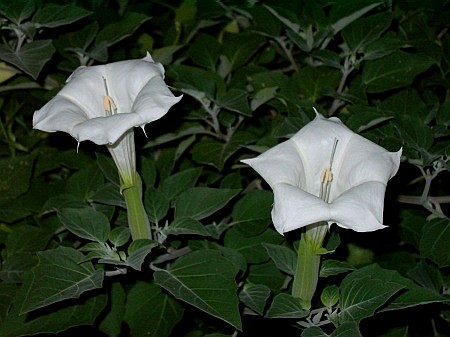Chosen-asagao
Chosen-asagao (Datura alba) contains a variety of potent anticholinergic alkaloids. The plant was an ingredient of Seishu Hanaoka's herbal concoction "Tsusensan", an orally administered general anaesthetic first used in early 19th century Japanese surgical medicine. Hanaoka's recipe evolved over many years in the course of his empirical research. Safer anaesthetic agents are now available.* * *
'TSUSENSAN': THE RECIPE
The recipe for Hanaoka’s anesthetic ('tsusensan') is as follows: one takes 8 parts of Datura alba (white angel trumpet or thornapple {D.stramonium, editor}), 2 parts of Aconium japonicum (Japanese aconite), 2 parts of Angelica dahurica (Chinese angelica), 2 parts Angelica decursiva (Norwegian angelica), 2 parts of Ligusticum wallichii and 2 parts Arisaema japonicum. The mixture is ground to a paste, boiled in water, and drunk warm. After 2 to 4 hours one will become impervious to pain and subsequently fall unconscious. Depending on the dosage, this effect will last 6 – 24 hours.The active ingredients in this concoction are scopolamine, hyoscyamine/atropine, aconitine and angelicotoxin. When combined, these give rise to anesthesia, sleep and paralysis, most important of these substances being the tropane alkaloids atropine (named after Atropa belladonna and still currently used by opthalmologists to dilate pupils), and the powerful scopolamine, both of which are substances which act to inhibit the transmission of stimuli between neurons (as acetylcholine antagonists).
(JH van D.)
HOME
Search
Resources
Snapshots
"Burundanga"
Utopian Surgery
Japan's Seishu Hanaoka
Refs and Further Reading
Anaesthesia and Anaesthetics
Japanese poineer Seishu Hanaoka developed first general anaesthetic
